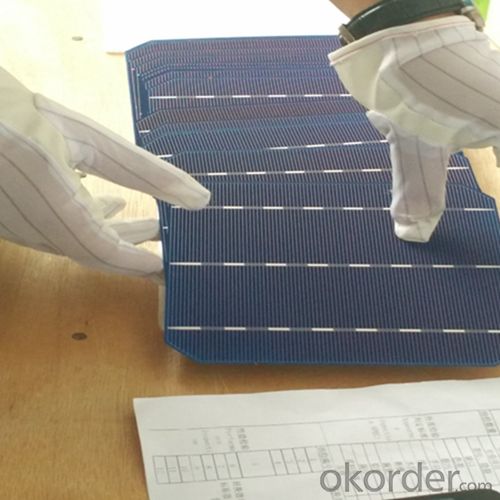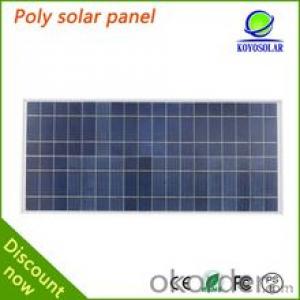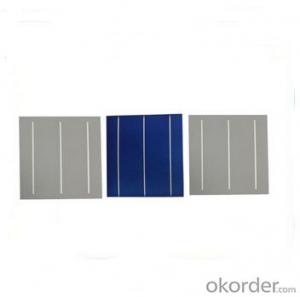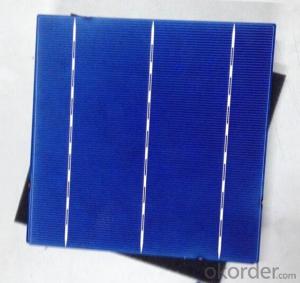Printable Organic Solar Cells - Poly 156mm x 156mm Solar Cells for Sale at Lowest Prices
- Loading Port:
- Shanghai
- Payment Terms:
- TT or LC
- Min Order Qty:
- 4999 watt
- Supply Capability:
- 6000000 watt/month
OKorder Service Pledge
OKorder Financial Service
You Might Also Like
The operation of a photovoltaic (PV) cell requires 3 basic attributes:
The absorption of light, generating either electron-hole pairs or excitons.
The separation of charge carriers of opposite types.
The separate extraction of those carriers to an external circuit.
In contrast, a solar thermal collector supplies heat by absorbing sunlight, for the purpose of either direct heating or indirect electrical power generation from heat. A "photoelectrolytic cell" (photoelectrochemical cell), on the other hand, refers either to a type of photovoltaic cell (like that developed by Edmond Becquerel and modern dye-sensitized solar cells), or to a device that splits water directly into hydrogen and oxygen using only solar illumination.Characteristic of Mono 156X156MM2 Solar Cells
You are gaining energy independence - add battery backup power for even greater energy security
The cost of electricity is only going to rise – insure against that rising cost
Adaptive cells change their absorption/reflection characteristics depending to respond to environmental conditions. An adaptive material responds to the intensity and angle of incident light. At the part of the cell where the light is most intense, the cell surface changes from reflective to adaptive, allowing the light to penetrate the cell. The other parts of the cell remain reflective increasing the retention of the absorbed light within the cell.[67]
In 2014 a system that combined an adaptive surface with a glass substrate that redirect the absorbed to a light absorber on the edges of the sheet. The system also included an array of fixed lenses/mirrors to concentrate light onto the adaptive surface. As the day continues, the concentrated light moves along the surface of the cell. That surface switches from reflective to adaptive when the light is most concentrated and back to reflective after the light moves along
Mechanical data and design
Format | 156mm x 156mm±0.5mm |
Thickness | 210μm±40μm |
Front(-) | 1.5mm bus bar (silver),blue anti-reflection coating (silicon nitride) |
Back (+) | 2.5mm wide soldering pads (sliver) back surface field (aluminium) |
Temperature Coefficient of Cells
Voc. Temp.coef.%/K | -0.35% |
Isc. Temp.coef .%/K | +0.024%/K |
Pm.Temp.coef. %/K | -0.47%/K |
Electrical Characteristic
Effiency(%) | Pmpp(W) | Umpp(V) | Impp(A) | Uoc(V) | Isc(A) | FF(%) |
18.35 | 4.384 | 0.526 | 8.333 | 0.63 | 8.877 | 78.39% |
18.20 | 4.349 | 0.526 | 8.263 | 0.63 | 8.789 | 78.54% |
18.05 | 4.313 | 0.525 | 8.216 | 0.63 | 8.741 | 78.32% |
17.90 | 4.277 | 0.524 | 8.161 | 0.625 | 8.713 | 78.04% |
17.75 | 4.241 | 0.523 | 8.116 | 0.625 | 8.678 | 77.70% |
17.60 | 4.206 | 0.521 | 8.073 | 0.625 | 8.657 | 77.36% |
17.45 | 4.170 | 0.519 | 8.039 | 0.625 | 8.633 | 76.92% |
17.30 | 4.134 | 0.517 | 8.004 | 0.625 | 8.622 | 76.59% |
17.15 | 4.096 | 0.516 | 7.938 | 0.625 | 8.537 | 76.80% |
17.00 | 4.062 | 0.512 | 7.933 | 0.625 | 8.531 | 76.18% |
16.75 | 4.002 | 0.511 | 7.828 | 0.625 | 8.499 | 75.34% |
16.50 | 3.940 | 0.510 | 7.731 | 0.625 | 8.484 | 74.36% |




 FAQ
FAQ
Q: What price for each watt?
A: It depends on the quantity, delivery date and payment terms, generally Large Quantity and Low Price
Q: What is your size for each module? Can you tell me the Parameter of your module?
A: We have different series of panels in different output, both c-Si and a-Si. Please take the specification sheet for your reference.
Q: What is your size for each module? Can you tell me the Parameter of your module?
A: We have different series of panels in different output, both c-Si and a-Si. Please take the specification sheet for your reference.
Solar cells through the photoelectric effect or photochemical effect directly convert light into electrical energy. In the photoelectric effect of thin-film solar cells work for the mainstream, how to buy solar cells haunt some people. This article briefly describes the knowledge about the solar optional. Hope it helps you.
Solar cells currently on the market are divided into amorphous and crystalline silicon. Where in the crystalline silicon can be divided into polycrystalline silicon and monocrystalline silicon. From the photoelectric conversion efficiency of the three materials of view: monocrystalline silicon (up to 17%)> polycrystalline silicon (12 to 15%)> amorphous silicon (about 5%). However, crystalline silicon (monocrystalline and polycrystalline) in low light to produce substantially no current, low-light-type amorphous silicon is better (in low light energy is inherently less). In general, it is more suitable to use silicon or polycrystalline silicon solar cell materials.
Selection Method of solar cell for sale
When we buy a solar cell, the focus is proportional to the area of solar power cells, in general, solar panel power with solar wafers concern. Solar cell area of the wafer is not exactly the same as the solar panel area of the package, because some solar panels though large, single-slot wide array of solar wafers, solar panels such power are not necessarily high.
Generally speaking, solar panel power is the bigger the better, so that the current produced under the sun will be large, built-in battery can be filled quickly. But in reality, a balance should be found in the need for solar panels and solar power portable charger. Solar power charger is generally considered the minimum of not less than 0.75w, secondary power solar panel under the standard light there is 140mA of current. In general, the current generated by the sun is about 100mA, if less than the second power charge current is too small, basically there will be no significant effect.
- Q: Can solar cells be used in smart grid systems?
- Yes, solar cells can be used in smart grid systems. Solar cells are a reliable and renewable source of energy that can generate electricity to power smart grids. They can be integrated into the grid infrastructure to provide clean and sustainable energy, reducing dependence on fossil fuels and contributing to the overall efficiency and sustainability of the smart grid system.
- Q: Can solar cells be used in portable devices?
- Yes, solar cells can be used in portable devices. They can convert sunlight into electrical energy, providing a sustainable and renewable power source for various portable devices such as smartphones, tablets, and even small appliances.
- Q: Many people said the usage of solar cell can reduce the cost overall, but does anyone agree with me that it actually cost a lot to operate a solar cell system?
- The reason why people said that is because the solar cell is using the sunlight, which is a free resources.
- Q: What should I know about the Crystalline silicon photovoltaic cells?
- Crystalline silicon (c-Si) is the crystalline forms of silicon, either multicrystalline silicon (multi-Si) consisting of small crystals, or monocrystalline silicon (mono-Si), a continuous crystal. Crystalline silicon is the dominant semiconducting material used in photovoltaic technology for the production of solar cells.
- Q: Friends are fuel cells are chemical energy into electricity, solar cells are converted into electricity into electricity I would like to know in addition to the structure and the conversion of different ways there are no other differences hope that the specific power of everyone
- building blocks of the scale and installation of flexible, fuel cell power plant area is small, the construction period is short, the power station can be assembled according to the needs of the battery stack, very convenient.
- Q: What is the environmental impact of manufacturing solar cells?
- The manufacturing of solar cells has both positive and negative environmental impacts. On the positive side, solar cells generate clean and renewable energy, reducing the reliance on fossil fuels and thereby decreasing greenhouse gas emissions and air pollution. Additionally, solar cells have a long lifespan and require minimal maintenance, reducing the overall environmental impact compared to other energy sources. However, the production process of solar cells does have some negative environmental consequences. The extraction of raw materials, such as silicon and rare earth metals, can lead to habitat destruction, water pollution, and soil degradation. The manufacturing process also requires energy and water, which can contribute to carbon emissions and water scarcity if not managed efficiently. Overall, while the production of solar cells does have some environmental impacts, it is important to consider them in relation to the significant environmental benefits that solar energy provides in terms of reducing carbon emissions and mitigating climate change.
- Q: What is the impact of solar cells on reducing electricity bills?
- Solar cells have a significant impact on reducing electricity bills as they harness the power of the sun to generate clean and renewable energy. By producing electricity on-site, solar cells can offset a considerable portion of a household's or business's energy consumption, leading to substantial savings on monthly electricity bills. Moreover, excess energy generated by solar cells can be fed back into the grid, allowing homeowners and businesses to earn credits or even receive payments for the surplus energy they contribute. Overall, solar cells offer a sustainable and cost-effective solution to reduce electricity bills and promote energy independence.
- Q: What are the main components of a solar cell?
- The main components of a solar cell are the semiconductor material (usually silicon), which absorbs sunlight and generates electrons, the metal contacts that allow the flow of current, and the transparent cover that protects the semiconductor from environmental factors while allowing sunlight to reach it.
- Q: Where can I buy solar cells on sale but still good quality ?
- Good solar cell sellers can get the best solar cells with highest quality as they have very strict quality control from material-during manufacturing-assemble-package; and they also check and test the structure strictly to ensure the whole solar mounting system can work under extreme weather condition;
- Q: Are solar cells affected by shade or partial shading?
- Yes, solar cells are significantly affected by shade or partial shading. Even a small amount of shade on a solar cell or panel can greatly reduce its overall efficiency and power output. This is because shading disrupts the flow of sunlight, preventing certain areas of the cell from receiving direct sunlight and therefore generating less electricity. It is important to ensure that solar panels are installed in areas with minimal shade to maximize their performance.
Send your message to us
Printable Organic Solar Cells - Poly 156mm x 156mm Solar Cells for Sale at Lowest Prices
- Loading Port:
- Shanghai
- Payment Terms:
- TT or LC
- Min Order Qty:
- 4999 watt
- Supply Capability:
- 6000000 watt/month
OKorder Service Pledge
OKorder Financial Service
Similar products
Hot products
Hot Searches
Related keywords































